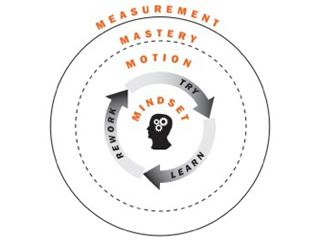
Rumsfeld describes how much thought he gave to Iraqi reconstruction
I’ve delayed posting this for a few days, in part because I just moved and I’m up to my armpits in cardboard boxes, but also because I wrote it initially for Duck of Minerva, the inside-baseball site for the international relations profession. My colleague Bob Kelly of Pusan National University in South Korea had written a group of posts on the IR profession and the 10th anniversary of the war, and I took issue with some of them; Bob, in the spirit of free exchange, asked me to write up my thoughts for the site, which he then re-posted at his site on Asian security issues.
The short version of what I’ve written is that I don’t think the irrational hating on George W. Bush is over yet, and until that ends, we’re not going to have a lot of productive discussions of the war. It took more than 10 years before we could have rational discussions about Vietnam, and I think we’re in a similar situation today. Of course, that’s generated some strong responses, including Dan Nexon of Georgetown, who took me to task pretty effectively for basically dismissing the war’s critics as victims of Bush Derangement Syndrome.
I’ll respond to Dan after thinking a bit more, but his criticisms are not entirely fair. A lot of conservatives, including me, despaired the day Bush hung medals on George “slam dunk” Tenet, Paul Bremer, and Tommy Franks, which was one of the most unseemly public screw-you pay-backs I’ve ever seen a president aim at his critics. Believe me, we’re not cheerleaders for W.
Moreover, critics (including Dan) have argued that I’m just kicking predictable venues like the New York Times in the shins. But this, if I may, is where the liberal “bubble” comes in: people who have never defended the war have no idea how fast any conversation with those of us who supported it degenerates into nearly rabid ranting about Bush and Cheney.
I mean, seriously: I could fill pages with examples of the visceral hatred of Bush and, perhaps even more so, of Vice President Dick Cheney. (My favorite? Former and present Congressman Alan Grayson, who once said he can’t concentrate on what Cheney says “because of the blood that drips from his teeth while he’s talking.” Nice.) I think we, as scholars, can’t ignore the degree to which our own profession, the national media, a significant portion of our political class, and many (if not most) entertainers and cultural leaders opposed the war mostly because they despised Bush personally. That emotional fixation on Bush warps the national conversation even today.
One more quick thought: think about the harsh, warlike rhetoric that came out of the Clinton administration in the late 1990s, and the way the national press and the Democrats in Congress lined up quickly to say that there was no death too horrible for Saddam. Indeed, it was Clinton, not Bush, who first tried to link al-Qaeda to Iraq. (Don’t believe me? Bet me. I dare you.)
So it was okay when Clinton said it, but when Bush said almost exactly the same thing, it was criminal negligence. Hmm. I’ll expand on this when I reply to Dan, but imagine — I mean just imagine — if Bush had launched an attack on a foreign country just before an impeachment vote. We’d still be burning him in effigy, instead of yukking it up with him as our first celebrity ex-Prez the way we do today with Clinton. I’m willing to accept that I’m being too hard on the war’s critics, but there is a major double-standard at work here.
Anyway, here’s the original piece. More to come.

I’ve been reading Bob Kelly’s thoughts – cogent as always – on the 10th anniversary of Iraq. I reject Bob’s exploration of the “culpability” of the IR field for providing any kind of intellectual infrastructure for the war, mostly because I don’t think anyone in Washington, then or now, listens to us, and for good reason. Joe Nye long ago lamented that lack of influence elsewhere, others agree by “others” I mean “me”) and so I won’t rehearse it here.
Bob and I sort of agree that the outcome of the war doesn’t say much about the prescience of at least some of the war’s opponents: there were people whose default position was almost any exercise of U.S. power is likely to be bad, and they don’t get points for being right by accident.
But Bob’s right to make the far more important point about what we do “if we knew then what we know now.” I’m not as sure as he is that there was ever a “neo-con theory of the war,” which I think grants too much coherence to Bush’s advisors. But he zeroes in on the key question: what, if any, arguments at this point can be mustered to defend the war?
After reading the various pieces here and thinking about Bob’s iterations of the discussion, here’s what I really think about Bob’s question on the tenth anniversary of the Iraq War:
I think it’s too soon.
Now, don’t get me wrong. I don’t mean it’s “too soon” to start sorting out the damage. Actually, the sooner we do that, the better. There’s a lot to learn from the war, and some of those lessons – especially about planning, dysfunctional civil-military relations, the dangers of script-writing an invasion, and the hazards of half-baked notions about “military transformation” – are already clear and should be incorporated into our thinking about national security.
I also don’t mean “too soon” in terms of drawing historical lessons – although I think it’s too soon for that, as well. I don’t think we know, really, anything about the long-term outcome of the war and its effect on either the Middle East or the world. That whole exercise, in which people who should know better confidently explain “What It All Means,” is pure nonsense. (Sadly, I said a lot of dumb things at the time, too. Guilty.)
IR scholars don’t need to be reminded that wars have unforeseeable consequences that can take a long, long time to coalesce. Seriously: imagine talking about the outcome of the Korean War a decade after its end. Truman left office with an approval rating measured in scientific notation. We replaced him with a four-star general after a national flirtation with Douglas MacArthur, whom history should revile more than it does. By 1963, “counter-insurgency” and “limited war” were all the rage. And really, it’s not like we’ll end up staying on the Korean peninsula for another fifty years or anything…
Or imagine reassessing Vietnam in 1985, ten years after the fall of Saigon. The United States is only just back on its feet after a crushing recession and a surge in Soviet power in the late 1970s. Who could deny that Vietnam was a miserable failure, a distraction and a foolish waste of resources? After all, the whole thing was really just a nationalist struggle that we misinterpreted as a communist coalition war, wasn’t it?
Now fast-forward after twenty years, to 1995. Now, the Soviet Union…wait, there isn’t a Soviet Union. Revelations from Moscow, Beijing, and Hanoi are just beginning to tell us an ugly story, one that involves words like “domino” and “theory” that no one would have taken seriously even twenty years earlier. Books like Michael Lind’s volume start appearing, in which Vietnam is called the Cold War’s “Dunkirk,” and the shouting starts all over again and hasn’t stopped since.
Let’s also admit there’s a dishonesty in all these “was it worth it?” discussions. There’s no adequate calculus for the measure of a human life; no one should look a grieving parent in the eye and say these wars, any of them, were worth it.

But again, none of this is why I think it’s too soon to talk about the war.
The real reason it’s “too soon” is that many American liberals and American academics (not always the same group, I grant) still cannot think rationally about the war because they still cannot let go of their desire for revenge on George W. Bush.
Sadly, this obsession with Bush really has far less to do with the war per se than with an overall burning hatred harbored by intellectuals for the 43rd president. So while I commend Bob for his calmness and his attempt to find some kind of path to a rational discussion here, I think that there still aren’t many people who are willing to think about this beyond their emotional reactions to Bush. (I can think of the exceptions, like NDU’s Joe Collins and his sobering 2008 report, and count them on one or two hands.)
Just look at some of the stuff that’s been published on the occasion of the anniversary by Bush’s critics, and you’ll see what I mean. All of it is aimed not so much at a consideration of Bob Kelly’s question – especially whether there was a good reason to go to war – but more at a furious attempt to hang everyone involved.
Gawker.com, for example, claimed to have hacked Bush’s personal email and invited people to “wish George Bush a Happy Iraq War Day.” The usual suspects – let’s just use Michael Moore, because he’s predictable – claimed that Bush basically got away with “murder,” and should be in jail.
But even people with intelligence and wisdom lose their perspective when talking about Bush and his coterie. Consider Andy Bacevich’s recent piece in Harper’s, where he taunts Paul Wolfowitz about writing a memoir. The piece is one of Bacevich’s best: there are a few people out there whose writing not only inspires me, but also provokes my envy at their skill. Andy is one of them.
That skill, however, doesn’t hide the fact that Bacevich doesn’t really want to have a discussion about the war. He wants Paul Wolfowitz – and pretty much everyone else involved in the war – to go before the American people, fall on their knees, and beg for mercy:
To be sure, whatever you might choose to say, you’ll be vilified, as Robert McNamara was vilifed when he broke his long silence and admitted that he’d been “wrong, terribly wrong” about Vietnam. But help us learn the lessons of Iraq so that we might extract from it something of value in return for all the sacrifices made there. Forgive me for saying so, but you owe it to your country.
Give it a shot.
Well. Who wouldn’t be inspired to write an honest and introspective book after that warning, which amounts to a demand not for a memoir, but for a confession? It’s like Brian Dennehy’s line in the classic movie Silverado, when he tells a captured man not to worry: “We’re going to give you a fair trial, and then a first-class hangin’.”
I’ve singled out Bacevich’s piece, paradoxically, because it’s good. It’s a great read. But the tone is pure acid – as are so many of the other “analyses” of the war.
This isn’t the place to go into why liberals hate Bush so much. That they do, and that they will violate even basic norms of intellectual inquiry when discussing his presidency, is beyond dispute. My colleague Steve Knott has written a devastating book whose title says it all: Rush to Judgment. Knott documented how presidential historians essentially discarded any scholarly standards in trying to assess the Bush presidency even before it was over.

History will vindicate us, right?
More recently, Steve did a piece in the Wall Street Journal pointing out that there was a time when almost everyone on the planet agreed that there were WMD in Iraq. (He also tells a great story about how someone in the Clinton administration, likely Madeleine Albright, wanted to engineer a military crisis with Iraq. How soon we forget.) Steve tells me that he has gotten hate mail for that piece like he’s never seen before. He’s a little surprised. I’m not.
My own theory is that intellectuals hated Bush not for what he did, but for who he was. Specifically, they hated him because he didn’t care about them. It’s important to remember that many people espouse politics as a form of self-actualization: they choose political positions based on what they think those positions say about themselves to others: “I support Obamacare because I love the poor, and that makes me a good person, and certainly a better person than you,” or “I hate gay marriage because Jesus loves me more than you and I’m going to Heaven.” Sanctimony is always the dread companion of political conviction.
Bush, in going to war, clearly didn’t care what a group of professors wanted, or what they said in a New York Times full-page ad. That whole thing, in fact, reminded me of a story I heard about Jesse Helms, which I could swear was printed somewhere back in the ‘90s, so maybe it’s not apocryphal. The short version is that some staffer came in all in a lather because the Times had, as usual, dumped on Helms, and the kid wanted to write a rebuttal. Helms said: “Well, son, that’s just fine, and you go ahead and do that, but I have to tell you: I don’t read the New York Times. And nobody I know reads the New York Times.”
If you want to piss off the New York Times and the people who adore it, that’s the quickest way to do it, because it says to them the one thing they cannot bear: You did not matter in this decision. And until those psychic wounds heal, a lot of people are going to carry just too much baggage into this discussion.
Still, Bob asked a real question, so at the end here, I’ll answer it.
I supported the war, just as I supported the 1991 war. (I drafted Senator John Heinz’s floor statement explaining his vote in that one.) I supported regime change in Iraq as early as 1994. Like most people, I thought we had done our job after kicking Saddam out of Kuwait. I underestimated his staying power, and I thought soon after the end of that first war that we had any number of reasons to go back to war, including Saddam’s plot to kill the first President Bush, his attempt to exterminate the Marsh Arabs, and his repeated violations of the UN cease-fire resolution.
Nonetheless, we screwed up the execution beyond belief. I have spent ten years in classrooms with many of the men and women who saw it first-hand, some of whom paid dearly for the arrogance of Rumsfeld and others. I am continually stunned by what I hear, and I can only agree with Ambassador Barbara Bodine, who often said: “There were 500 ways to do it wrong, and two or three ways to do it right. What I we didn’t understand was that we were going to go through all 500.”
That doesn’t mean I think the war was immoral, criminal, or based on lies. I think lives, American, Allied, and Iraqi, were recklessly thrown away, just as they were in the horrendous island-hopping campaign in the Pacific in World War II, as they were in the push to the Chinese border in Korea, as they were every day in Vietnam.
But unlike a lot of my colleagues, I don’t think I know what the war “means” just yet. And I’m not ready to convene any kangaroo courts: not for Bush, not for his advisors, not for the media, not for the academy, nor for anyone else.
At least not yet.



 Turning 60 a few weeks back was quite a trip. It’s one of those milestones that prompts reflection as well as plenty of celebration. (My wife,
Turning 60 a few weeks back was quite a trip. It’s one of those milestones that prompts reflection as well as plenty of celebration. (My wife, 







 The length of time it takes for the coconut to toast will depend on its size and thickness, so watch it closely to prevent burning. Once the coconut is toasted to your liking, remove it from the oven and allow it to cool.
The length of time it takes for the coconut to toast will depend on its size and thickness, so watch it closely to prevent burning. Once the coconut is toasted to your liking, remove it from the oven and allow it to cool.
















 This is a guest post from Susan Alexander of
This is a guest post from Susan Alexander of 
